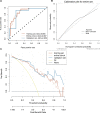Predictors of cognitive impairment in patients undergoing ileostomy for colorectal cancer: a retrospective analysis
- PMID: 37304889
- PMCID: PMC10249619
- DOI: 10.7717/peerj.15405
Predictors of cognitive impairment in patients undergoing ileostomy for colorectal cancer: a retrospective analysis
Abstract
Background: Early detection of cognitive impairment in patients undergoing ileostomy for colorectal cancer may help improve patient outcomes and quality of life. Identifying risk factors and clinically accessible factors is crucial for prevention and treatment.
Objective: This retrospective study aimed to identify risk factors for post-operative cognitive impairment in patients undergoing ileostomy for colorectal cancer and to explore potential factors for its prevention and treatment.
Methods: A total of 108 cases were selected and included in the study. Patient data including general characteristics, disease stage, complications, and chemotherapy status were collected, and sleep quality and cognitive function were assessed using questionnaires and follow-up. Patients were randomly divided into training and validation groups. A random forest model was used to rank clinical features based on their contribution to predicting the prognosis of cancer-related cognitive impairment (CRCI). Nomograms were constructed using the support vector machine-recursive feature elimination (SVM-RFE) method, and the minimal root-mean-square error (RMSE) values were compared to select the best model. Regression analysis was performed to determine independent predictors.
Results: Significant differences were observed in age, body mass index (BMI), alcohol consumption, frequency of physical activity, comorbidity, and cancer-related anemia (CRA) between the CRCI and non-CRCI groups. Random forest analysis revealed that age, BMI, exercise intensity, PSQI scores, and history of hypertension were the most significant predictors of outcome. Univariate logistic regression analysis of 18 variables revealed that age, alcohol consumption, exercise intensity, BMI, and comorbidity were significantly associated with the outcome of CRCI (p < 0.05). Univariate and multivariate models with P-values less than 0.1 and 0.2, respectively, showed better predictive performance for CRCI. The results of univariate analysis were plotted on a nomogram to evaluate the risk of developing CRCI after colorectal cancer surgery. The nomogram was found to have good predictive performance. Finally, regression analysis revealed that age, exercise intensity, BMI, comorbidity, and CRA were independent predictors of CRCI.
Conclusions: This retrospective cohort study revealed that age, exercise intensity, BMI, comorbidity, CRA, and mobility are independent predictors of cognitive impairment in patients undergoing ileostomy for colorectal cancer. Identifying these factors and potential factors may have clinical implications in predicting and managing post-operative cognitive impairment in this patient population.
Keywords: Clinical predictive models; Cognitive impairment; Ileostomy; Postoperative; Retrospective analysis.
©2023 Xu et al.
Conflict of interest statement
The authors declare there are no competing interests.
Figures






Similar articles
-
A Prediction Model for Cognitive Impairment Risk in Colorectal Cancer after Chemotherapy Treatment.Biomed Res Int. 2021 Feb 20;2021:6666453. doi: 10.1155/2021/6666453. eCollection 2021. Biomed Res Int. 2021. Retraction in: Biomed Res Int. 2024 Mar 20;2024:9808217. doi: 10.1155/2024/9808217. PMID: 33688501 Free PMC article. Retracted. Clinical Trial.
-
The association between inflammation-related biomarkers and the subtypes of cancer-related cognitive impairment in colorectal cancer patients: A latent profile analysis.Eur J Oncol Nurs. 2024 Feb;68:102493. doi: 10.1016/j.ejon.2023.102493. Epub 2023 Dec 18. Eur J Oncol Nurs. 2024. PMID: 38134496
-
A Predictive Model for the Risk of Cognitive Impairment in Patients with Gallstones.Biomed Res Int. 2021 Jul 17;2021:3792407. doi: 10.1155/2021/3792407. eCollection 2021. Biomed Res Int. 2021. Retraction in: Biomed Res Int. 2024 Mar 20;2024:9890654. doi: 10.1155/2024/9890654. PMID: 34337006 Free PMC article. Retracted.
-
Cancer-related cognitive impairment: updates to treatment, the need for more evidence, and impact on quality of life-a narrative review.Ann Palliat Med. 2024 Sep;13(5):1265-1280. doi: 10.21037/apm-24-70. Epub 2024 Sep 9. Ann Palliat Med. 2024. PMID: 39260437 Review.
-
Chemotherapy-related cognitive impairment in older patients with cancer.J Geriatr Oncol. 2016 Jul;7(4):270-80. doi: 10.1016/j.jgo.2016.04.008. Epub 2016 Jul 5. J Geriatr Oncol. 2016. PMID: 27197918 Free PMC article. Review.
Cited by
-
Comparing the sensitivity of fatigue and sleep disturbance assessment tools in women with advanced cancer undergoing chemotherapy.Asia Pac J Oncol Nurs. 2023 Oct 31;11(2):100331. doi: 10.1016/j.apjon.2023.100331. eCollection 2024 Feb. Asia Pac J Oncol Nurs. 2023. PMID: 38283667 Free PMC article.
-
Advances in risk prediction models for cancer-related cognitive impairment.Clin Exp Med. 2025 Mar 6;25(1):74. doi: 10.1007/s10238-025-01590-6. Clin Exp Med. 2025. PMID: 40047952 Free PMC article. Review.
-
Preoperative quantitative quadriceps muscle ultrasound to predict POD for gastrointestinal surgery in older patients.BMC Gastroenterol. 2025 Mar 24;25(1):198. doi: 10.1186/s12876-025-03782-6. BMC Gastroenterol. 2025. PMID: 40128647 Free PMC article.
-
The Influence of Sociodemographic Factors and Clinical Aspects on the Quality of Life of Surgically Treated Patients with Colorectal Cancer.Cancer Manag Res. 2024 Sep 27;16:1293-1303. doi: 10.2147/CMAR.S478179. eCollection 2024. Cancer Manag Res. 2024. PMID: 39355765 Free PMC article.
-
The Effects of Appropriate Perioperative Exercise on Perioperative Neurocognitive Disorders: a Narrative Review.Mol Neurobiol. 2024 Jul;61(7):4663-4676. doi: 10.1007/s12035-023-03864-0. Epub 2023 Dec 19. Mol Neurobiol. 2024. PMID: 38110646 Free PMC article. Review.
References
-
- Andreev A, Erdinc B, Shivaraj K, Schmutz J, Levochkina O, Bhowmik D, Farag F, Money KM, Primavera LH, Gotlieb V, Sahni S. The association between anemia of chronic inflammation and alzheimer’s disease and related dementias. Journal of Alzheimer’s Disease Reports. 2020;4:379–391. doi: 10.3233/ADR-200178. - DOI - PMC - PubMed
Publication types
MeSH terms
LinkOut - more resources
Full Text Sources
Medical

